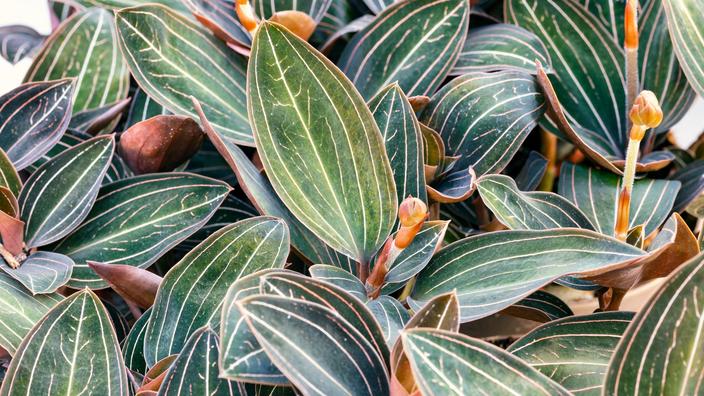The
jewel orchids
whose Latin names are multiple
Ludisia discolor, Macodes petola
or
Anoectochilus formosanus
are part of the botanical family of
orchids
.
To discover
True or false: fight misconceptions about the garden
What are the different types of jewel orchids?
Ludisia discolor
, described in this sheet, is the jewel orchid that can be obtained most easily in garden centres.
But there are others belonging to different botanical genera such as
Macodes petola
or
Anoectochilus formosanus
which are grown in the same way.
Uses:
Indoor plants.
What are the characteristics of jewel orchids?
Native to southern China and Indochina to Sumatra,
jewel orchids
are small plants grown primarily for the beauty of their foliage.
They have a short, fleshy rhizome from which vertical stems emerge, each crowned with a rosette of soft, downy leaves, dark green to bronze in color with creamy white or red veins.
These rosettes give rise to floral stalks measuring 20 to 30 centimeters high adorned with about thirty white flowers with yellow hearts exhaling a light fragrance.
Flowering period:
Flowering lasts between 2 and 3 weeks, in spring or early summer.
Flowering of the jewel orchid lasts between 2 and 3 weeks, in spring or early summer.
Adobe Stock
Hardiness:
Jewel orchids are frost-proof plants that require temperatures equal to or greater than 18°C, summer and winter.
Read alsoOrchids: 10 mistakes to avoid
How to grow jewel orchids?
Difficulty level
: Difficult.
The substrate must always be moist, knowing that excessive watering can cause the roots to rot.
Exposure:
Due north or behind an east-facing window with sheer because
Ludisia discolor
fears excess light.
Sowing/planting:
The multiplication is done by sowing
in vitro
but this delicate technique to implement is mainly intended for professionals.
Amateurs instead practice dividing the clumps when repotting.
You can also make stem cuttings, after the wound has healed, in a glass of water or in horticultural compost that is always moist.
Read alsoOrchid, the flower with masculine attributes
Cultivation management:
· Hygrometry: 75 to 80% all year round.
In strong heat, spray lukewarm rainwater all around the foliage twice a day.
· Watering: regular throughout the year, added with diluted fertilizer once in two.
In autumn and winter, space out the waterings and remove the fertilizer if the temperature should drop between 15 and 18°C.
· Repotting: every 2 years, when the plant overflows its pot.
The container should be a wide but shallow cup because the rhizome quickly covers the available surface.
· Substrate: 60% fine-grained pine bark, 30% horticultural compost, and 10% charcoal in small pieces to prevent root rot in the event of excessive watering.
A little sphagnum for young plants if you tend to water infrequently.
· Fertilizer: Fertilizer for flowering plants in half doses, every 15 days.
Read alsoDo indoor plants make you happier?
Common diseases and parasites:
The
Ludisia
is especially afraid of mealybugs, which should not be allowed to take hold.
These sucking insects always start under the leaves.
An inspection every two weeks at most can eliminate them before they reproduce.
Watch out for snails and slugs if you take the plant out in the summer.
Sheet written by Philippe Lemettais, SNHF, Orchids section

